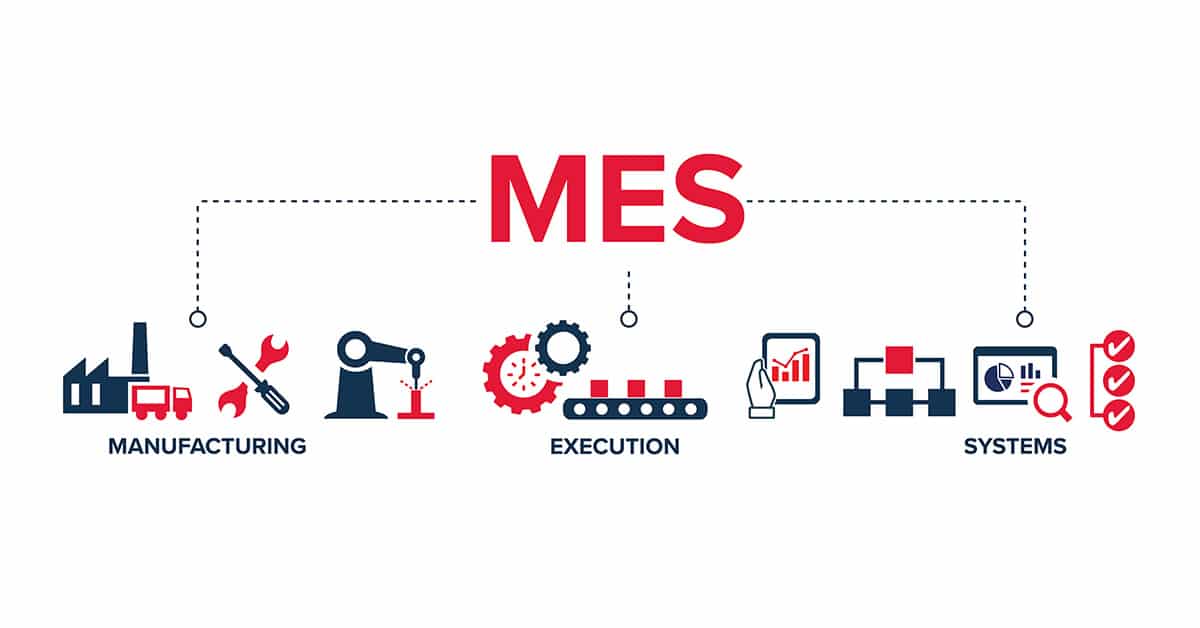With the wealth of data that can — and should — be collected and monitored using today’s industrial technology, the need for a unified tool to record, analyze, synthesize and store this information is more important than ever. A Manufacturing Execution System (MES) is an effective way to meet this need, providing operational oversight and communication while integrating seamlessly with both enterprise-and process-level systems.
Read on to learn more about what an MES in manufacturing is and how it works.
What is a manufacturing execution system (MES)?
A Manufacturing Execution System is software that enables monitoring, control and connectivity across the process-level equipment throughout the facility and organization. The system also acts as an intermediary between production activities and enterprise-level planning and objectives, facilitating transparency and communication through every level of the business.
The primary objective of an MES is to improve operational efficiency and productivity by gaining real-time insight into processes and performance, and enabling controls and responses to signals and situations where abnormalities are detected, or where efficiencies can be gained. The MES helps stakeholders at every level of the organization to better achieve objectives and outcomes by providing a link from ERP-level planning to machine-level data and control.
How does an MES work?
An MES works on the basis of real-time, always-on communication with systems throughout the facility (and in some cases, with operational systems outside of the facility in question). Operating as a data collection, analysis and management platform, the MES leverages Industry 4.0 and IIoT technology, including:
- Industrial sensors
- Communications infrastructure
- Connected/smart equipment
- Analytics tools and software
- Cloud storage
- And more, depending on the needs of the organization and the applications of the system
The MES needs to be able to communicate with a broad range of equipment, software languages, communication standards, and other factors — a detail which accounts for a large component of the complexity of an MES. With this communication capability in place, the system enables managers and operators to see the big picture of equipment operations, productivity and efficiency more easily, and to make decisions and take action directly through the system.
MES hierarchy & architecture
MES architecture is based on an operational hierarchy of several levels, as defined by the ANSI/ISA-95 standard. The hierarchy is based on the applications and objectives of several different operational functions throughout the facility, and roughly drills down from big-picture enterprise-level functions to actual production itself. The hierarchy is as follows:
Level 4: Business planning and logistics
This level involves the top-level planning of plant operations: material usage, production forecasting, delivery and fulfillment needs, and more. At this level, long-term operational objectives are also of concern, and data is synthesized to produce expected resource requirements over the forthcoming months and years.
Level 3: Operations management
The operations level represents the largest opportunity to realize the benefits of MES software. This is the level at which an MES actively analyzes and compares process data against operational objectives and provides the opportunity for real-time reactions and adjustments to maximize efficiency. This level also incorporates record keeping and long-term analysis of processes and outcomes.
Level 2: Manufacturing control (2)
In conjunction with Level 1 processes, this level involves high-level monitoring of manufacturing functions, automation inputs and supervisory analytical actions.
Level 1: Manufacturing control (1)
This level involves process-level sensors and monitoring processes and provides baseline data for all upstream levels.
Level 0: Production
“Level 0,” as part of MES in manufacturing industry standards, represents the production process itself.
Benefits of manufacturing execution systems
The benefits of manufacturing execution system technology are many:
- Improved efficiency: With a big-picture, 360-degree, real-time view of operations, processes, inventory and usage, an MES can help to ensure that processes and resources are being used as effectively as possible.
- Reduced downtime: An MES can facilitate predictive maintenance thanks to the massive amount of data being processed, which can reduce or eliminate costly unplanned downtime.
- Less waste: By providing more transparency into material usage and increased control over production processes, MES systems can reduce unneeded expenditures.
- System integration: An MES can act as an intermediary between machine-level data transmission and enterprise-level objectives and requirements. Given the range of communication systems and standards in use today, the MES should be able to comply with and process numerous standards and methods.
MES standards
As mentioned, an MES should be able to comply with a number of communication standards. These may include OPC-UA; OPC-DA; SECS/GEM and IPC-CFX; for IIoT, it includes BLE and MQTT, BatchML, PackML, MIMOSA, REST, B2MML, ODBC and more.
Manufacturing execution systems form an important backbone of today’s industrial technology implementations, enabling organizations to get the most out of their infrastructure investments and industrial technology solutions.


